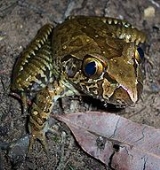
Giant Barred Frog
Encyclopedia
The Giant Barred Frog, Mixophyes iteratus, is a species of barred frogs
in Australia
. It occurs from south-east Queensland
to just south of the Newcastle
region in New South Wales
. It is associated with flowing streams and creeks in wet sclerophyll and rainforest habitats from the coast to the ranges.
The call of this species is a deep grunting noise, males call in the spring and summer from the edges of streams after rain. During amplexus the female kicks the eggs up onto an overhanging bank or rocks. The eggs stick to this surface until heavy rain when they may be washed into the water, or without heavy rains to wash the eggs into the water the tadpoles simply fall into the water 8–10 days after laying. The tadpoles of this species grow very large, up to 84mm and are among the largest in Australia.
This species has suffered a noted decline in past years.
Barred frogs
The barred frogs are a group of frogs in the genus Mixophyes. They are the largest of the Australian ground frogs, from the Myobatrachidae family....
in Australia
Australia
Australia , officially the Commonwealth of Australia, is a country in the Southern Hemisphere comprising the mainland of the Australian continent, the island of Tasmania, and numerous smaller islands in the Indian and Pacific Oceans. It is the world's sixth-largest country by total area...
. It occurs from south-east Queensland
Queensland
Queensland is a state of Australia, occupying the north-eastern section of the mainland continent. It is bordered by the Northern Territory, South Australia and New South Wales to the west, south-west and south respectively. To the east, Queensland is bordered by the Coral Sea and Pacific Ocean...
to just south of the Newcastle
Newcastle, New South Wales
The Newcastle metropolitan area is the second most populated area in the Australian state of New South Wales and includes most of the Newcastle and Lake Macquarie Local Government Areas...
region in New South Wales
New South Wales
New South Wales is a state of :Australia, located in the east of the country. It is bordered by Queensland, Victoria and South Australia to the north, south and west respectively. To the east, the state is bordered by the Tasman Sea, which forms part of the Pacific Ocean. New South Wales...
. It is associated with flowing streams and creeks in wet sclerophyll and rainforest habitats from the coast to the ranges.
Physical description
This is Australia's second largest species of frog reaching a maximum size of about 120mm. This frog is normally dark brown on the dorsal surface with some spots of variable size in a darker colour. The upper half of the iris is golden in colour, with the bottom half being darker, a thin dark stripe runs from the snout, through the eye, and down past the tympanum. There is a dark triangle shape on the end of the snout starting from the nostril, with a paler triangle present behind it stretching to the eye. The legs are very strongly barred and the toes are fully webbed. The thighs and side are pale yellowish in colour with many darker spots also present in this area. The underbelly is white.Ecology and behaviour
This species is always found close to water, normally permanent flowing creeks, however they will sometimes also inhabit dams in wet sclerophyll and rainforest.The call of this species is a deep grunting noise, males call in the spring and summer from the edges of streams after rain. During amplexus the female kicks the eggs up onto an overhanging bank or rocks. The eggs stick to this surface until heavy rain when they may be washed into the water, or without heavy rains to wash the eggs into the water the tadpoles simply fall into the water 8–10 days after laying. The tadpoles of this species grow very large, up to 84mm and are among the largest in Australia.
This species has suffered a noted decline in past years.

